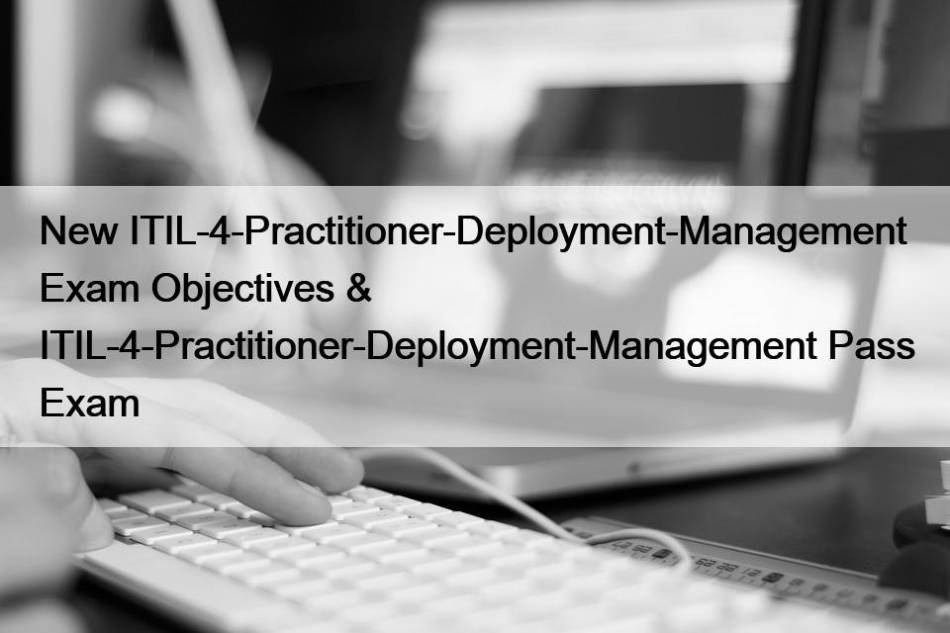Most Popular
 SAP C-AIG-2412 Free Exam & C-AIG-2412 Study Materials
SAP C-AIG-2412 Free Exam & C-AIG-2412 Study Materials
To some extent, to pass the C-AIG-2412 exam means that ...
 Juniper JN0-452 Valid Exam Practice - JN0-452 VCE Exam Simulator
Juniper JN0-452 Valid Exam Practice - JN0-452 VCE Exam Simulator
In your day-to-day life, things look like same all the ...
 Study Your Huawei H19-308-ENU Exam with Accurate Valid H19-308-ENU Test Review Certainly
Study Your Huawei H19-308-ENU Exam with Accurate Valid H19-308-ENU Test Review Certainly
The HCSA-Presales-Storage (H19-308-ENU) practice exam consists of a HCSA-Presales-Storage (H19-308-ENU) ...



New ITIL-4-Practitioner-Deployment-Management Exam Objectives & ITIL-4-Practitioner-Deployment-Management Pass Exam

Our ITIL-4-Practitioner-Deployment-Management exam simulation is selected many experts and constantly supplements and adjust our questions and answers. When you use our ITIL-4-Practitioner-Deployment-Management study materials, you can find the information you need at any time. When we update the ITIL-4-Practitioner-Deployment-Management preparation questions, we will take into account changes in society, and we will also draw user feedback. If you have any thoughts and opinions in using our ITIL-4-Practitioner-Deployment-Management Study Materials, you can tell us. We hope to grow with you and the continuous improvement of ITIL-4-Practitioner-Deployment-Management training engine is to give you the best quality experience.
Peoplecert ITIL-4-Practitioner-Deployment-Management Exam Syllabus Topics:
| Topic | Details |
|---|---|
| Topic 1 |
|
| Topic 2 |
|
| Topic 3 |
|
| Topic 4 |
|
>> New ITIL-4-Practitioner-Deployment-Management Exam Objectives <<
ITIL-4-Practitioner-Deployment-Management Pass Exam, ITIL-4-Practitioner-Deployment-Management Download Demo
The DumpsFree is a leading platform that has been assisting the Peoplecert ITIL-4-Practitioner-Deployment-Management exam candidates for many years. Over this long time period countless ITIL-4-Practitioner-Deployment-Management exam candidates have passed their Peoplecert ITIL-4-Practitioner-Deployment-Management Exam. They got success in ITIL 4 Practitioner: Deployment Management exam with flying colors and did a job in top world companies.
Peoplecert ITIL 4 Practitioner: Deployment Management Sample Questions (Q10-Q15):
NEW QUESTION # 10
[Understand the Key Concepts of Deployment Management]
Which is a key feature of continuous deployment which is not found in other CI/CD stages?
- A. It automatically tests software code
- B. It enables users to benefit immediately from changes
- C. It predominantly uses staging environments
- D. It allows individual decisions about software releases
Answer: B
Explanation:
Continuous deployment (CD) in ITIL 4 is the most advanced stage of the CI/CD pipeline, where every validated change is automatically deployed to production without manual intervention. The key feature unique to continuous deployment, not found in continuous integration or continuous delivery, is that it enables users to benefit immediately from changes (Option B), as changes reach production instantly after passing automated tests.
Option A (It automatically tests software code): Incorrect, as automated testing is a feature of continuous integration and continuous delivery, not unique to continuous deployment.
Option B (It enables users to benefit immediately from changes): Correct, as continuous deployment automatically pushes validated changes to production, delivering value to users without delay, unlike other CI/CD stages.
Option C (It predominantly uses staging environments): Incorrect, as continuous deployment minimizes reliance on staging environments, deploying directly to production.
Option D (It allows individual decisions about software releases): Incorrect, as continuous deployment eliminates manual release decisions, relying on automation for consistency.
NEW QUESTION # 11
[Use Tools and Techniques for Deployment]
Which automation tools should be used to transport and install configuration items into a test environment?
- A. Work planning and prioritization tools
- B. Service configuration management tools
- C. Environment configuration and management tools
- D. Deployment tools
Answer: D
Explanation:
In ITIL 4, deployment tools are specifically designed to automate the transportation and installation of configuration items (CIs) into various environments, including test environments. These tools ensure consistency, repeatability, and efficiency in deployment processes, which are critical for managing CIs during testing phases.
Option A (Deployment tools): Correct, as deployment tools (e.g., Jenkins, Ansible, or Terraform for certain use cases) are tailored for automating the movement and installation of CIs, ensuring they are correctly placed in test environments with minimal manual intervention.
Option B (Environment configuration and management tools): While these tools (e.g., Puppet, Chef) manage environment settings, their primary focus is on configuring and maintaining environments, not transporting or installing CIs, making them less relevant here.
Option C (Work planning and prioritization tools): Tools like Jira or Trello focus on task management and prioritization, not on automating CI deployment, so this option is incorrect.
Option D (Service configuration management tools): These tools manage relationships and data about CIs in a configuration management database (CMDB), not the physical transport or installation of CIs, ruling out this option.
NEW QUESTION # 12
[Measure and Improve Deployment Management]
An IT service manager is analyzing a value stream that is used to deploy new and changed services. The manager has interviewed many staff and has identified all the workflow steps. The manager is now evaluating the workflow steps so that they can plan improvements. Which activity should the manager carry out as part of this evaluation?
- A. Define an ideal series of workflow steps for the future
- B. Identify wasteful steps that could be eliminated
- C. Collect data about what happens in each workflow step
- D. Establish what value is created in each workflow step
Answer: D
Explanation:
ITIL 4's value stream analysis focuses on understanding the contribution of each step to overall value delivery to identify improvement opportunities. When evaluating workflow steps, the manager should establish what value is created in each step (Option D), as this provides the foundation for assessing whether steps are necessary, effective, or aligned with organizational goals.
Option A (Collect data about what happens in each workflow step): Incorrect, as data collection is part of identifying steps (already done, per the question), not evaluating their value.
Option B (Identify wasteful steps that could be eliminated): Incorrect, as identifying waste is a subsequent action that depends on first understanding the value of each step.
Option C (Define an ideal series of workflow steps for the future): Incorrect, as defining future steps is part of planning improvements, not evaluating current steps.
Option D (Establish what value is created in each workflow step): Correct, as evaluating value per step is critical to understanding the stream's effectiveness and prioritizing improvements, per ITIL 4.
NEW QUESTION # 13
[Apply Deployment Management Processes]
An organization is deploying new software and new servers to support a service that will be launched soon. Which TWO of these activities should the organization conduct as part of the 'verification of the service components' activity of the 'deployment lifecycle management' process?
Checking that the correct models of server have been supplied
Testing the software for defects
Creating a schedule for installing the new servers
Installing the new software to the newly installed servers
- A. 2 and 3
- B. 3 and 4
- C. 1 and 2
- D. 1 and 4
Answer: C
Explanation:
In ITIL 4, the 'verification of service components' activity within the deployment lifecycle management process ensures that delivered components meet specifications before deployment. The correct activities are:
Activity 1 (Checking that the correct models of server have been supplied): Part of verification, as it confirms that the hardware components match requirements.
Activity 2 (Testing the software for defects): Part of verification, as it ensures the software is functional and free of critical issues before deployment.
Activity 3 (Creating a schedule for installing the new servers): Incorrect, as scheduling is a planning activity, not verification.
Activity 4 (Installing the new software to the newly installed servers): Incorrect, as installation is part of the deployment execution, not verification.
NEW QUESTION # 14
[Apply Deployment Management Processes]
What key output of the 'deployment model development and improvement' process can be used to trigger implementation of a newly updated deployment model?
- A. Updated knowledge management articles
- B. Lessons learned
- C. Change request
- D. Deployment review reports
Answer: C
Explanation:
In ITIL 4, the deployment model development and improvement process involves creating or refining models to enhance deployment effectiveness. Implementing a newly updated deployment model typically requires formal authorization and coordination, which is achieved through a change request (Option B). A change request initiates the process to assess, approve, and execute the model update in a controlled manner, ensuring alignment with organizational governance and other practices like change enablement.
Option A (Lessons learned): Incorrect, as lessons learned are an output for improving future processes, not a trigger for implementing a new model.
Option B (Change request): Correct, as a change request is the formal mechanism to propose and implement a new or updated deployment model, per ITIL 4's integration with change enablement.
Option C (Updated knowledge management articles): Incorrect, as knowledge articles support documentation and training but do not trigger implementation.
Option D (Deployment review reports): Incorrect, as review reports provide insights or feedback, not the authorization needed to implement a model.
NEW QUESTION # 15
......
May be you doubt the ability of our Peoplecert test dump; you can download the trial of our practice questions. All ITIL-4-Practitioner-Deployment-Management exam prep created by our experienced IT workers who are specialized in the certification study guide. We checked the updating of ITIL-4-Practitioner-Deployment-Management vce braindumps to make sure the preparation successful.
ITIL-4-Practitioner-Deployment-Management Pass Exam: https://www.dumpsfree.com/ITIL-4-Practitioner-Deployment-Management-valid-exam.html
- Genuine Peoplecert ITIL-4-Practitioner-Deployment-Management Exam Questions [2025] 🥇 Search for ⇛ ITIL-4-Practitioner-Deployment-Management ⇚ and download it for free on ➠ www.prep4sures.top 🠰 website 👺ITIL-4-Practitioner-Deployment-Management Reliable Test Duration
- Expert Validation Use Up-to-Date Q-As to Pass the Peoplecert ITIL-4-Practitioner-Deployment-Management Exam 🌿 Open website { www.pdfvce.com } and search for ( ITIL-4-Practitioner-Deployment-Management ) for free download 🤕ITIL-4-Practitioner-Deployment-Management Valid Test Objectives
- Peoplecert New ITIL-4-Practitioner-Deployment-Management Exam Objectives Exam 100% Pass | ITIL-4-Practitioner-Deployment-Management Pass Exam 🅾 Enter ▷ www.prep4away.com ◁ and search for 「 ITIL-4-Practitioner-Deployment-Management 」 to download for free ❣Pdf ITIL-4-Practitioner-Deployment-Management Torrent
- 2025 New ITIL-4-Practitioner-Deployment-Management Exam Objectives | Latest ITIL-4-Practitioner-Deployment-Management Pass Exam: ITIL 4 Practitioner: Deployment Management 100% Pass 🎻 Search on 「 www.pdfvce.com 」 for ✔ ITIL-4-Practitioner-Deployment-Management ️✔️ to obtain exam materials for free download 🪓ITIL-4-Practitioner-Deployment-Management Latest Exam Dumps
- Genuine Peoplecert ITIL-4-Practitioner-Deployment-Management Exam Questions [2025] 📎 Open ➠ www.lead1pass.com 🠰 enter ➽ ITIL-4-Practitioner-Deployment-Management 🢪 and obtain a free download 😵Latest ITIL-4-Practitioner-Deployment-Management Dumps Files
- ITIL-4-Practitioner-Deployment-Management Valid Test Objectives ✴ ITIL-4-Practitioner-Deployment-Management Latest Exam Dumps 🎧 Latest ITIL-4-Practitioner-Deployment-Management Dumps Files 🚊 Enter ▛ www.pdfvce.com ▟ and search for 「 ITIL-4-Practitioner-Deployment-Management 」 to download for free ⚪ITIL-4-Practitioner-Deployment-Management Practice Exams
- Free PDF Perfect Peoplecert - ITIL-4-Practitioner-Deployment-Management - New ITIL 4 Practitioner: Deployment Management Exam Objectives 👄 Go to website ( www.prep4away.com ) open and search for [ ITIL-4-Practitioner-Deployment-Management ] to download for free 💫Reliable ITIL-4-Practitioner-Deployment-Management Study Plan
- ITIL-4-Practitioner-Deployment-Management Reliable Test Duration 🦜 ITIL-4-Practitioner-Deployment-Management Reliable Test Tips 🌄 ITIL-4-Practitioner-Deployment-Management Practice Exams 🥚 Open website 「 www.pdfvce.com 」 and search for ➥ ITIL-4-Practitioner-Deployment-Management 🡄 for free download 🥏ITIL-4-Practitioner-Deployment-Management Latest Exam Dumps
- New ITIL-4-Practitioner-Deployment-Management Exam Objectives 100% Pass | Latest ITIL-4-Practitioner-Deployment-Management Pass Exam: ITIL 4 Practitioner: Deployment Management 🐷 Enter ➤ www.pass4test.com ⮘ and search for ✔ ITIL-4-Practitioner-Deployment-Management ️✔️ to download for free 🅿ITIL-4-Practitioner-Deployment-Management Reliable Test Duration
- Genuine Peoplecert ITIL-4-Practitioner-Deployment-Management Exam Questions [2025] 🥚 Easily obtain ➥ ITIL-4-Practitioner-Deployment-Management 🡄 for free download through ➡ www.pdfvce.com ️⬅️ 👦ITIL-4-Practitioner-Deployment-Management Exam Collection Pdf
- Free PDF Perfect Peoplecert - ITIL-4-Practitioner-Deployment-Management - New ITIL 4 Practitioner: Deployment Management Exam Objectives 🏺 The page for free download of ➤ ITIL-4-Practitioner-Deployment-Management ⮘ on { www.prep4pass.com } will open immediately 🖼Learning ITIL-4-Practitioner-Deployment-Management Mode
- ITIL-4-Practitioner-Deployment-Management Exam Questions
- courseguild.com mdiaustralia.com dev.postulcuapa.ro qlearning.net 64maths.com elearning.centrostudisapere.com cybernetlearning.com edulingo.online www.lingogurugerman.com mediaidacademy.com
Tags: New ITIL-4-Practitioner-Deployment-Management Exam Objectives, ITIL-4-Practitioner-Deployment-Management Pass Exam, ITIL-4-Practitioner-Deployment-Management Download Demo, ITIL-4-Practitioner-Deployment-Management Latest Test Labs, Exam ITIL-4-Practitioner-Deployment-Management Cost